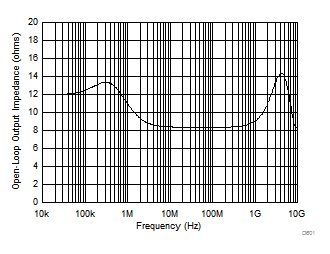ZHCSII6C July 2018 – January 2023 OPA855
PRODUCTION DATA
- 1 特性
- 2 应用
- 3 说明
- 4 Revision History
- 5 Device Comparison Table
- 6 Pin Configuration and Functions
- 7 Specifications
- 8 Parameter Measurement Information
- 9 Detailed Description
- 10Application, Implementation, and Layout
- 11Device and Documentation Support
- 12Mechanical, Packaging, and Orderable Information
9.3.4 Slew Rate and Output Stage
In addition to wide bandwidth, the OPA855 features a high slew rate of 2750 V/µs. The slew rate is a critical parameter in high-speed pulse applications with narrow sub-10-ns pulses, such as optical time-domain reflectometry (OTDR) and LIDAR. The high slew rate of the OPA855 implies that the device accurately reproduces a 2-V, sub-ns pulse edge, as seen in Figure 7-20. The wide bandwidth and slew rate of the OPA855 make it an excellent amplifier for high-speed signal-chain front ends.
Figure 9-7 shows the open-loop output impedance of the OPA855 as a function of frequency. To achieve high slew rates and low output impedance across frequency, the output swing of the OPA855 is limited to approximately 3 V. The OPA855 is typically used in conjunction with high-speed pipeline ADCs and flash ADCs that have limited input ranges. Therefore, the OPA855 output swing range coupled with the class-leading voltage noise specification maximizes the overall dynamic range of the signal chain.
 Figure 9-7 Open-Loop Output Impedance
(ZOL) vs Frequency
Figure 9-7 Open-Loop Output Impedance
(ZOL) vs Frequency